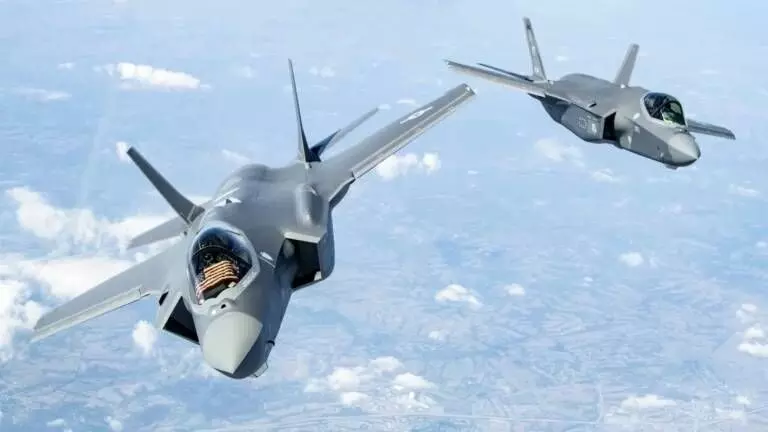Top 10 Largest Air Forces in the World in 2025: Who Rules the Skies?
Discover the top 10 largest air forces in the world in 2025, ranked by total military aircraft. See where global powers stand in aerial strength.
image for illustrative purpose

In modern warfare, military might is no longer measured solely by the size of a country’s army. Air power—defined by speed, agility, and the ability to dominate the skies—has become a crucial element in national defence and global influence. As aerial technology evolves and geopolitical tensions rise, nations are investing heavily in expanding and modernizing their air forces.
Based on the latest data compiled through 2024 and published by World Population Review, here are the ten largest air forces in the world in 2025, ranked by the total number of active military aircraft. From superpowers to emerging players, the list reflects both size and strategic intent.
1. United States — 14,486 Aircraft
The United States maintains a commanding lead in global air power. With more than 14,000 aircraft in service, the U.S. military operates the most advanced and diverse aerial fleet in the world. This includes stealth fighters like the F-22 Raptor and F-35 Lightning II, heavy bombers such as the B-2 Spirit and B-52 Stratofortress, and a vast array of support aircraft.
This total encompasses aircraft from all branches of the U.S. military—Air Force, Navy, Marine Corps, and Army—ensuring rapid response capability and global reach. With a widespread network of overseas bases, the U.S. continues to project air power on every continent.
2. Russia — 4,292 Aircraft
Russia holds the second spot with over 4,000 military aircraft, reflecting its long-standing emphasis on aerospace strength. The fleet includes strategic bombers like the Tu-160 “White Swan”, advanced fighters such as the Su-35, and its latest fifth-generation jet, the Su-57.
Despite economic challenges, Russia continues to prioritize the modernization of its air force. Its aircraft are known for ruggedness and reliability, often designed for performance in extreme environments.
3. China — 3,304 Aircraft
China’s People’s Liberation Army Air Force (PLAAF) has seen rapid expansion over the past decade. Now the third-largest in the world, the PLAAF includes next-generation aircraft like the J-20 stealth fighter, J-16 multirole jet, and Y-20 transport aircraft.
China’s military aviation sector has grown with strong government backing, emphasizing indigenous production and reducing dependence on foreign technology. This modernization aligns with China’s broader geopolitical ambitions in the Indo-Pacific and beyond.
4. India — 2,296 Aircraft
India ranks fourth globally with nearly 2,300 aircraft across its Air Force, Army Aviation Corps, and Naval Air Arm. This might come as a surprise to some, but reflects India’s increasing focus on aerospace capability to defend its borders and assert regional leadership.
The Indian Air Force (IAF) operates a mixed fleet that includes Russian Su-30MKIs, French Rafales, and the domestically developed HAL Tejas. Through initiatives like Make in India, India is actively promoting self-reliance in defence manufacturing.
5. Japan — 1,459 Aircraft
Japan's Air Self-Defense Force is one of the most advanced in Asia. With nearly 1,500 aircraft, including F-35 Lightning II stealth fighters and upgraded F-15Js, Japan maintains a technologically sophisticated fleet.
Amid rising regional tensions, particularly in East Asia, Japan continues to enhance its air defence and surveillance capabilities. The country also maintains strong military ties with the United States, engaging in joint exercises and co-development programs.
6. Pakistan — 1,434 Aircraft
Pakistan comes in sixth, narrowly behind Japan. The Pakistan Air Force (PAF) fields a diverse range of aircraft including U.S.-made F-16s, Chinese JF-17 Thunders, and French Mirage fighters.
Despite limited resources compared to some of its neighbors, Pakistan has built a robust and balanced air force focused on defence, deterrence, and strike capabilities. Strategic partnerships, especially with China, continue to drive fleet upgrades and joint development efforts.
7. South Korea — 1,171 Aircraft
The Republic of Korea Air Force (ROKAF) has evolved into a highly capable force, with more than 1,100 aircraft. Its fleet includes F-35As, KF-16s, and the indigenous KAI T-50 trainers. A major milestone is the development of the KF-21 Boramae, South Korea’s own fifth-generation fighter.
Given ongoing tensions with North Korea, South Korea prioritizes readiness, precision strike capability, and technological innovation in its air force strategy.
8. Egypt — 1,093 Aircraft
Egypt maintains one of the largest air forces in Africa and the Middle East. Its 1,000+ aircraft come from a variety of sources, including American F-16s, French Rafales, and Russian-made models.
Egypt’s strategic location at the crossroads of three continents means its air force plays a key role in regional security, counterterrorism, and peacekeeping operations. It also reflects Egypt’s balanced approach to international military partnerships.
9. Turkey — 1,069 Aircraft
Turkey’s air force supports both national defence and NATO missions. Its fleet includes F-16s and a growing array of unmanned systems like the Bayraktar TB2, which have proven successful in recent conflicts and drawn global attention.
The Turkish defence industry is expanding rapidly, with increased investment in local aircraft development and a growing focus on drones and electronic warfare capabilities.
10. France — 972 Aircraft
France closes the top 10 with a highly mobile and versatile air force. Operating the Dassault Rafale multirole fighter, France’s air power extends beyond national defence to missions across Europe, Africa, and the Middle East.
The French Air and Space Force is a vital part of NATO operations and contributes to EU defence cooperation. Its global deployment capability and overseas territories require a flexible, expeditionary air force.
The Global Air Power Landscape in 2025
These rankings offer a snapshot of how nations prioritize air power in their defence strategies. While numbers tell part of the story, capability, readiness, and technology are equally important. India's rise to fourth place, in particular, underscores its growing strategic role in Asia and its commitment to aerospace innovation.
In a world where threats can arise at supersonic speed, these air forces aren’t just tools of war—they’re symbols of sovereignty, security, and technological ambition.

